Useful and creative plasticine modeling captivates and develops the child. This accessible and safe material allows you to create interesting crafts on any topic. Children of grades 2-4 develop psychologically with the help of such activities. Following step-by-step instructions, they will be able to make various characters with minimal help from adults.
Modeling with plasticine in elementary school: the benefits and goals of creative activities
Working with plasticine helps develop fine motor skills.
During this process, children also improve and develop:
- logical thinking;
- memory;
- motor coordination;
- speech;
- perseverance and patience;
- creativity;
- abstract and figurative understanding;
- imagination;
- attentiveness;
- emotional state;
- self-esteem;
- visual-motor coordination;
- manual touch;
- observation and eye.
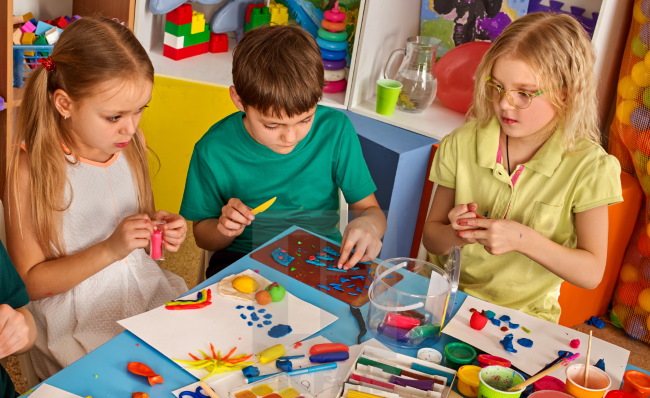
The objectives of plasticine modeling are:
- formation of ideas about shapes and colors;
- safety training with material during classes;
- stimulation of fantasy and imagination;
- distraction from irritating and harmful factors;
- learning to cope with your own anxieties and fears;
- improving the condition of the nervous system and the body as a whole;
- developing self-confidence;
- development of interest in creativity;
- formation of aesthetic taste;
- teaching the volumetric method of depicting objects.
Types of beautiful and safe plasticine for children
The table will introduce safe and non-toxic types of plasticine for children:
| Type of plasticine | Material Features |
| Classical | It can be soft or hard; it gets dirty easily and is difficult to wash off. |
| Wax | Very soft and adheres well. |
| Ballpoint | In the form of weightless granules, which are connected by harmless glue; it can glow in the dark and adheres perfectly to paper. |
| Freezing | It dries within 24 hours and is suitable for creating entire collections of crafts, such as Christmas tree decorations. |
| Art plasticine | The hard one is intended for three-dimensional crafts, and the soft one is for plasticine painting and appliqués. |
| Floating | Non-melting crafts made from it are capable of floating. |
Tools and auxiliary materials
The following tools should be available for creating crafts from plasticine:
- scissors;
- natural materials;
- beads;
- various base materials;
- frames;
- rags;
- napkins;
- stable containers with cold and hot water;
- rounded and pointed stacks;
- boards for work;
- oilcloth;
- apron and elbow pads.
Step-by-step description of the technology of plasticine crafts
Plasticine figures and appliques in school lessons will help to mold thematic illustrations and riddles. Making crafts from plastic material in grades 2-4 allows you to consolidate previously acquired skills. Step by step following the instructions, children learn to achieve what they want and complete what they started.
Pets
Plasticine cow step by step:
- First, roll 2 balls of orange and brown colors.
- The light ball is attached to the dark one.
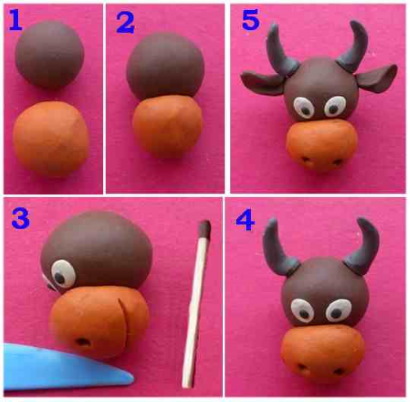
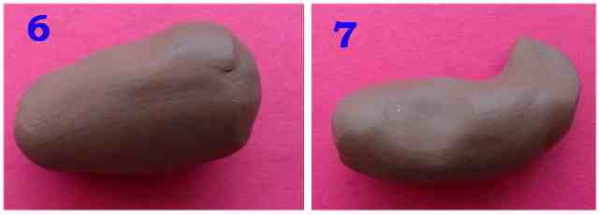
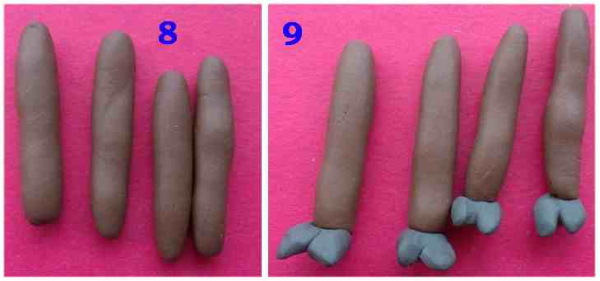
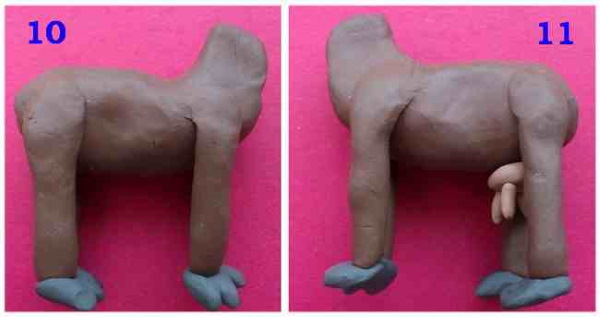
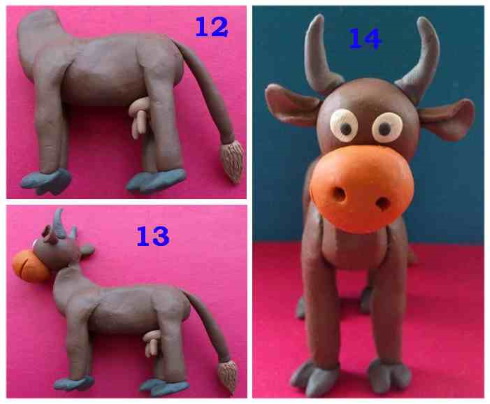
- Eyes are glued to the brown piece, and the nostrils are pierced on the orange piece with a matchstick and a smile is drawn with a stack.
- Horns are made from grey pieces and attached to the head of the future cow.
- Below, attach ears made from brown, slightly pressed plasticine cakes.
- Next, from another large brown piece, make an oval, the future body of the craft, which is pressed with fingers. Then pull out the end, forming the neck of the pet.
- The cow's legs are made from brown sticks, in which toothpicks or matches are hidden for stability.
- Hooves made of grey plasticine are attached to the ends of the legs.
- Next, the limbs are attached to the body of the craft and the folds are smoothed out with fingers so that they are not visible.
- A cow's udder is constructed from beige material and then attached.
- A long thin tail with a beige tassel at the end is made from brown plasticine.
- All the parts are put together to create a complete cow.
Wild animals
Modeling a plasticine snail:
- From 2 pieces of material roll a large and a small ball of orange and brown colors.
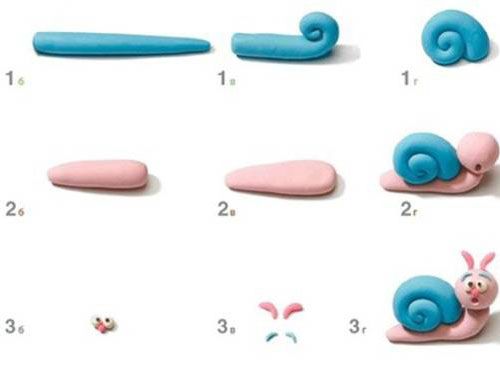
- The larger piece is rolled into a thin, long sausage and twisted into a shell.
- A sausage is also made from a smaller part, but shorter and wider. It is then bent at a right angle. This will be the snail's body. It is flattened at the base.
- Next, the previously made shell is attached to the flat part of the body.
- Eyes are made from white and black plasticine and attached to the top of the body using wire.
Sea creatures
Creating an octopus:
- The plasticine block is divided into 5 parts, 1 of which should be larger than the others.
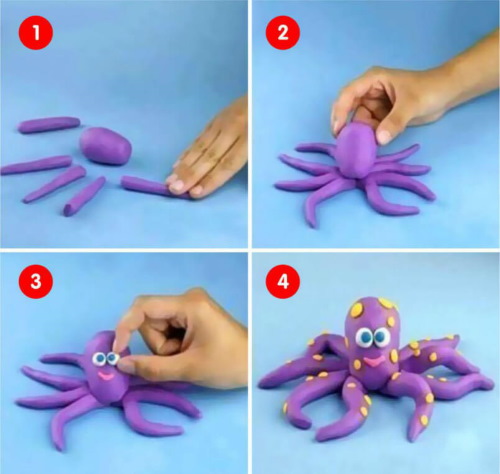
- Next, all the parts are rolled into balls.
- From 4 balls make 8 thin sausages, which are intertwined to form an eight-pointed star.
- The resulting figure will become the basis for the craft.
- Its ends or paws are covered with darker plasticine dots.
- Each of the specks is pierced with a rod or skewer. This way the legs will turn into tentacles.
- The large ball is made oblong with a widened top.
- Eyes are attached to the resulting octopus head and a mouth is drawn on it.
- The snowflake made of tentacles is turned over and a head with a dotted crown is attached to it.
- All that remains is to bend all the tentacles upwards so that the octopus looks like a real one.
Insects
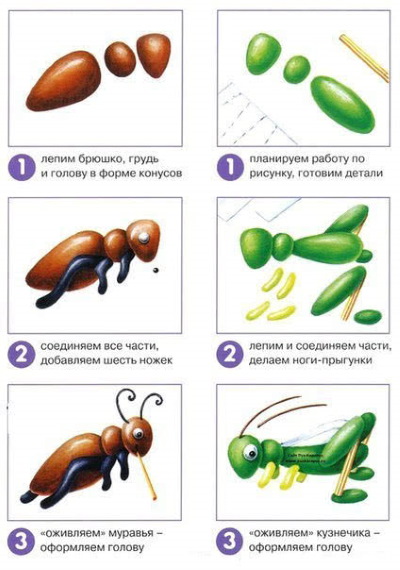 Plasticine grasshopper craft:
Plasticine grasshopper craft:
- Balls of various sizes are made from green material.
- From the largest piece they mold an oblong body and attach the head to it.
- They draw notches on the body with a stack, and attach eyes to the head.
- Form the wings from 2 more balls. They should be narrow and flattened.
- The resulting parts are attached to the abdomen and placed one after the other.
- Then make large hind legs and attach them to the lower part of the body so that the folds point upwards.
- The remaining 4 plasticine balls are used to make small grasshopper limbs. They are rolled into tubes, which are then bent and attached to the sides of the abdomen.
- Then take 2 more small pieces of plasticine and make long antennae out of them, putting them on a wire for stability. The resulting blanks are attached to the head, directing their ends to the opposite edge of the craft.
Floristics
Crafts from plasticine (2nd grade) gradually introduce younger schoolchildren to the diversity of the surrounding world. Children learn not only about different forms, but also about how the inhabitants of the fauna and flora are arranged.

Solar dandelion from plasticine, algorithm:
- A long sausage is rolled from the yellow material.
- The blank is flattened and trimmed with a stack. Then, fringe is made along its entire length with scissors.
- The resulting flagellum is twisted to form a fluffy inflorescence.
Vegetables
While making vegetables from plasticine, children:
- create beautiful food for dolls;
- get acquainted with plant species;
- learn colors;
- become familiar with simple geometric shapes and their names;
- having a fun time.
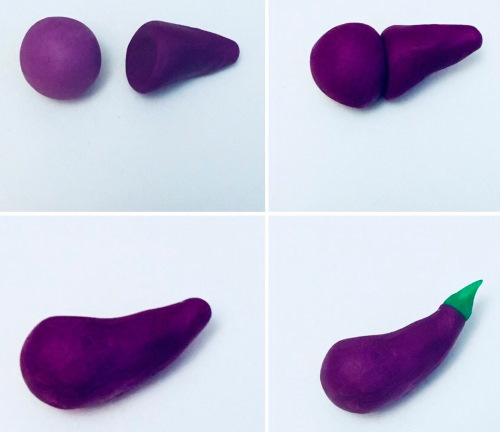
Modeling plasticine eggplants:
- Take purple or dark blue material and form balls out of it.
- Before creating eggplants, look at drawings or photographs of them. The balls are rolled into sausages, which are then bent. From green plasticine, the stalks are made in the form of flat cakes and sticks.
- Using a plastic knife, make stars from the flat cakes, which are then attached to the blue blanks. The stalk is then tightly pressed around the circumference. A sausage is glued to the top.
- The same process is used for other blue-colored preparations if several eggplants were planned.
Fruits
Algorithm for creating a pear from plasticine:
- Flagella are rolled from pieces of plasticine of different colours (red, yellow, orange and green).
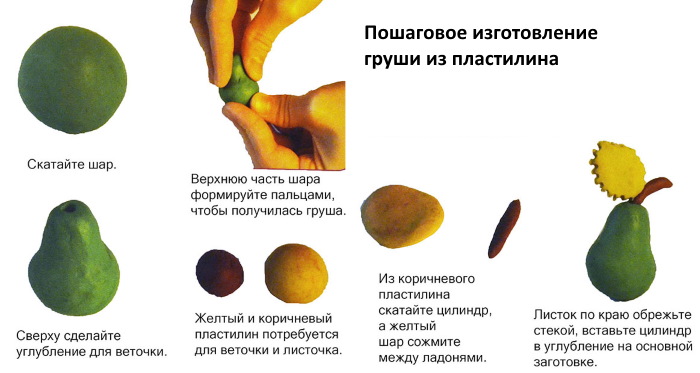
- The resulting sausages are intertwined and mixed until a multi-colored ball is formed.
- Then it is given a pear shape.
- A brown stalk and a green leaf made from plasticine are attached to the narrower part of the product.
Transport
Crafts from plasticine (grade 3), the step-by-step creation of which is described by detailed instructions, and the process of modeling itself teach schoolchildren to be neat and independent. Children with such tangible creativity get used to trusting their feelings and the directions of the mentor.
Instructions for making a plasticine T-14 tank:
- The grey mass is kneaded to form a rectangular block the size of a matchbox.


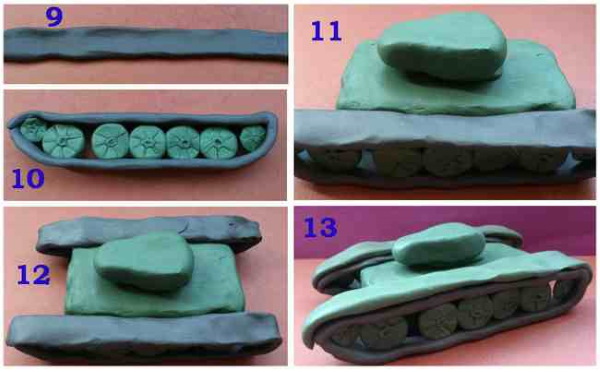
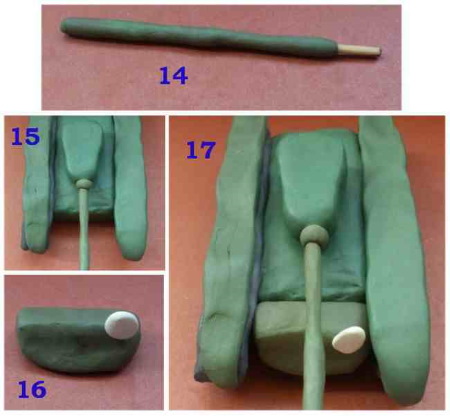
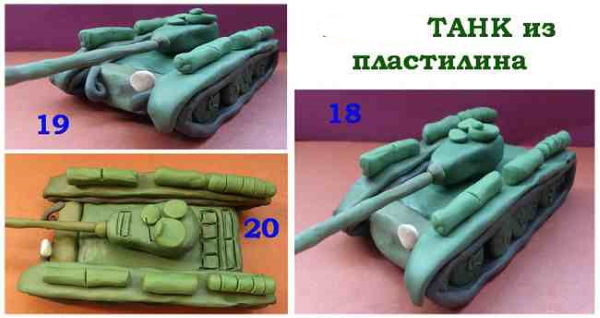
- The tank hull is turned on its side and its lower corners are carefully cut off at an angle with a stack.
- The rear of the combat vehicle is pressed slightly upward, and the front is simply flattened on both sides.
- Black and grey plasticine are mixed and 12 small wheels are molded, which are then attached, 6 in each row, to the lower sides of the tank.
- The wheel rows are wrapped with caterpillar tracks made of long sausages.
- The compartments are marked on the body with a stack.
- The upper turret of the tank is made from a small block and a flat semicircular part with reliefs applied to them.
- Take a wooden stick and cover it with grey plasticine. Attach another rectangular block to the end that remains sticking out.
- Next, a tank is assembled from the prepared parts.
Cartoon characters
Plasticine Crocodile Gena:
- A head is made from a green ball.

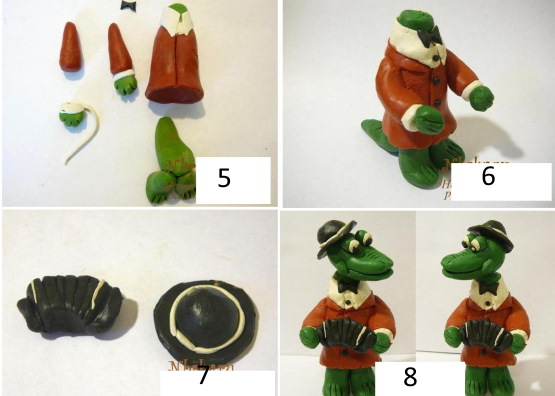
- Then they insert eyes into it and put on a hat made of black plasticine.
- Next, they create a raspberry-colored jacket, attach a white collar and a black bow tie to it.
- Green paws are attached to the sleeves.
- Legs made of blue plasticine with black boots are strung on matches, with the help of which they will be attached to the body.
- The jacket is decorated with a row of black buttons.
- At the end, the head and legs are attached to the crocodile's body.
Paintings-appliques
Crafts from plasticine (4th grade), the step-by-step creation of which is described in the article, at this age the child already sculpts more consciously. The products already have a more neat and professional look.
By the way, playing with plasticine helps children cope with stress and calm down.
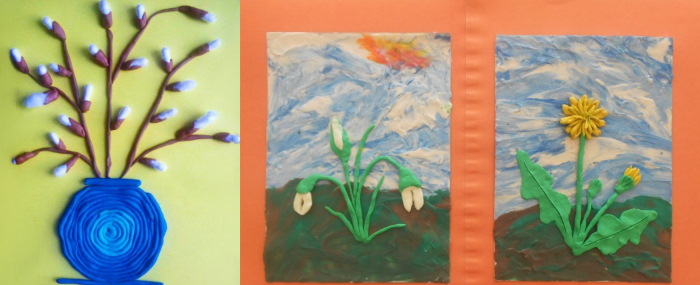
Spring panel, creation:
- Blue plasticine is rolled out thinly and used to cover half of the disk.
- The remaining part is filled with green material, leveling it with a rolling pin.
- A flat cake is made from white plasticine and a primrose is cut out of it with a stack.
- Several of these flowers need to be made.
- The stems and leaves are made from green flagella.
- A sun is cut out of yellow plasticine and placed in the sky of the panel.
Toys
Barbecue with shashlik for dolls, modeling:
- For the toy craft, in addition to the gray plasticine, take 7 matches and a short box.
- The soft material is thinly flattened to the size of the paper blank.
- The plasticine cake is stuck onto the box and the surface is smoothed out with fingers.
- Holes are made at the top for skewers.

- Take 4 matches and apply grey plasticine to them.
- Next, they are attached to the bottom of the grill.
- Brown and beige plasticine circles are strung onto matchstick skewers, alternating them.
- Skewers with shashlik are placed into the grill holes.
New Year's crafts
The decorated Christmas tree is made as follows:
- Roll out a very long sausage from green plasticine, or better yet, several, which can then be connected together during the process.
- The resulting bundles begin to twist into a spiral, forming a Christmas tree.
- They make decorations from multi-colored plasticine balls and decorate the finished craft with them.
- Beads or glitter can replace plasticine decor. The top of the tree is decorated with a molded star.
Easter crafts
Making a festive basket with eggs:
- A basket is made from red plasticine.
- Multi-colored plasticine eggs are placed inside.
- A bush is made from green material, which should be larger than the basket. It can be decorated with molded multi-colored flowers.
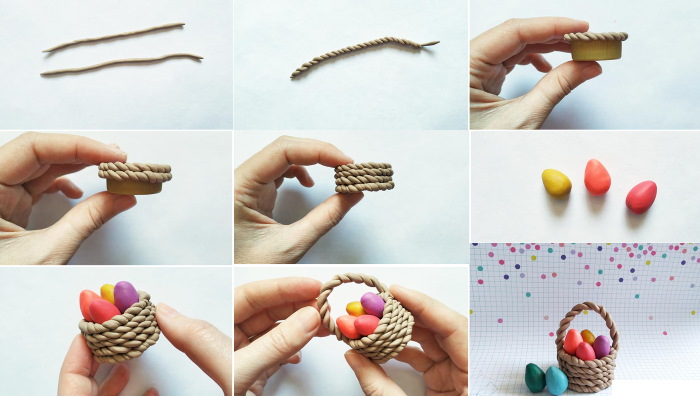
- At the end of the work, the Easter basket is attached to the center of the bush.
- The composition, which you won’t be ashamed to even place on the festive table, can be additionally decorated with live plants or molded ladybugs.
By creating crafts from soft and pliable material, children in grades 2-4 master the images and techniques of the process. Modeling from plasticine is a type of fine art that forms a child's aesthetic taste. Step-by-step following of the instructions for making products helps develop memory and logic.
Author: tanyda
Video about modeling from plasticine
Crafts from plasticine:

Thanks for the good work